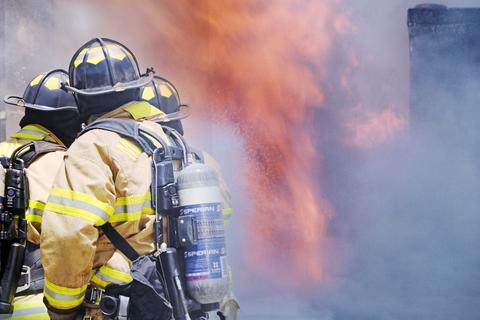Summary
PFAS (Per- and Polyfluoroalkyl Substances) are synthetic chemicals linked to health and environmental risks, and firefighters may face increased exposure due to PFAS in their gear and workplace environments. However, there is limited data on PFAS levels in these settings, and current methods for collecting and analyzing PFAS are not well understood. This study aims to improve PFAS analysis methods, assess firefighter gear and workplaces for PFAS contamination, and share the results to guide the development of standards, policies, and best practices to reduce firefighter exposure.
Description

OBJECTIVE:
To advance and use per- and polyfluoroalkyl substances (PFAS) collection and analysis tools and methodologies to characterize PFAS in firefighter gear and workplace environments. The findings of this research will support the development of standards, policies, and best practices to reduce firefighter exposure to PFAS.
Problem:
Per- and polyfluoroalkyl substances (PFAS) are a family of over 6,000 synthetic chemicals widely used in consumer and industrial applications. However, they pose significant health and environmental risks. Growing evidence suggests that firefighters may face additional exposure risks due to PFAS in their gear and workplace environments. Despite this concern, scientific data on PFAS presence in firefighter gear and workplaces is limited. Additionally, there is a lack of understanding regarding the accuracy, uncertainty, and practical application of PFAS collection and analysis methods, which are essential for making informed risk-reduction decisions.
Research Plan:
This study aims to improve PFAS collection and analysis methods, apply them to assess PFAS in firefighter gear and workplace environments, and share findings to support the development of measurement standards, policies, and best practices to reduce firefighter exposure.
The main tasks are:
- Characterizing Methodologies. To ensure the reliability and trust of PFAS collection, sample preparation, and analysis methods by evaluating their accuracy, reproducibility, strengths, and limitations. This includes
- assessing techniques for collecting non-volatile and volatile PFAS from fabrics, residues, and gases (e.g., wipes, gear, thermal desorption tubes),
- developing appropriate sample preparation methods (e.g., direct analysis, solvent extraction) based on PFAS volatility and sample type (gas, liquid, or solid)
- using advanced analytical tools such as combustion ion chromatography, liquid chromatography-mass spectrometry (LC-MS/MS), and gas chromatography/mass spectroscopy (GC-MS), and novel methodologies (e.g., targeted and non-targeted analysis) quantify/quantify PFAS levels.
- Assessing PFAS in Firefighter Gear. To measure the type, amount, and prevalence of PFAS in firefighter gear, including structural firefighting (jackets, pants, gloves, hoods, and breathing systems) and wildland firefighter (jacket, shirts, and pants) gear. This includes analyzing new gear as well as stressing and analyzing gear subjected to stressors that mimic real-world use (e.g., abrasion, thermal exposure, and laundering).
- Assessing PFAS in Firefighter Workplaces. To analyze PFAS presence in firefighter workplaces, such as fire stations, fire trucks, and fire scenes. This includes collecting and analyzing samples from air (passive and active gas), surfaces (wipes), gear, and local other products (e.g., furniture, debris).
- Disseminating Research. To release datasets and reports on our PFAS firefighter research. Also to actively engage with standards organizations, federal and non-federal working groups, and industry committees to share findings, provide expert guidance, and identify future PFAS firefighter research needs for NIST.
Major Accomplishments
- Senate and publicly released report describing the methodologies and measurement accuracy and uncertainty of 55 PFAS characterized from 21 NEW (2020) structural firefighter jacket and pants. News release and report: https://www.nist.gov/news-events/news/2023/05/researchers-pin-down-pfas-prevalence-firefighter-gear
- Senate and publicly released report describing the methodologies and measurement accuracy and uncertainty of 55 PFAS characterized from 21 structural firefighter jacket and pants post-stressing (e.g., abrasion and laundering. News release and report: https://www.nist.gov/news-events/news/2024/01/wear-and-tear-may-cause-firefighter-gear-release-more-forever-chemicals
- NIST report describing the methodologies and measurement accuracy and uncertainty of 55 PFAS characterized from NEW structural firefighter gloves (4) and hoods (8) and wildland firefighter apparel (9). News release and report: https://www.nist.gov/news-events/news/2024/12/pfas-found-firefighter-gloves-hoods-and-wildland-gear

